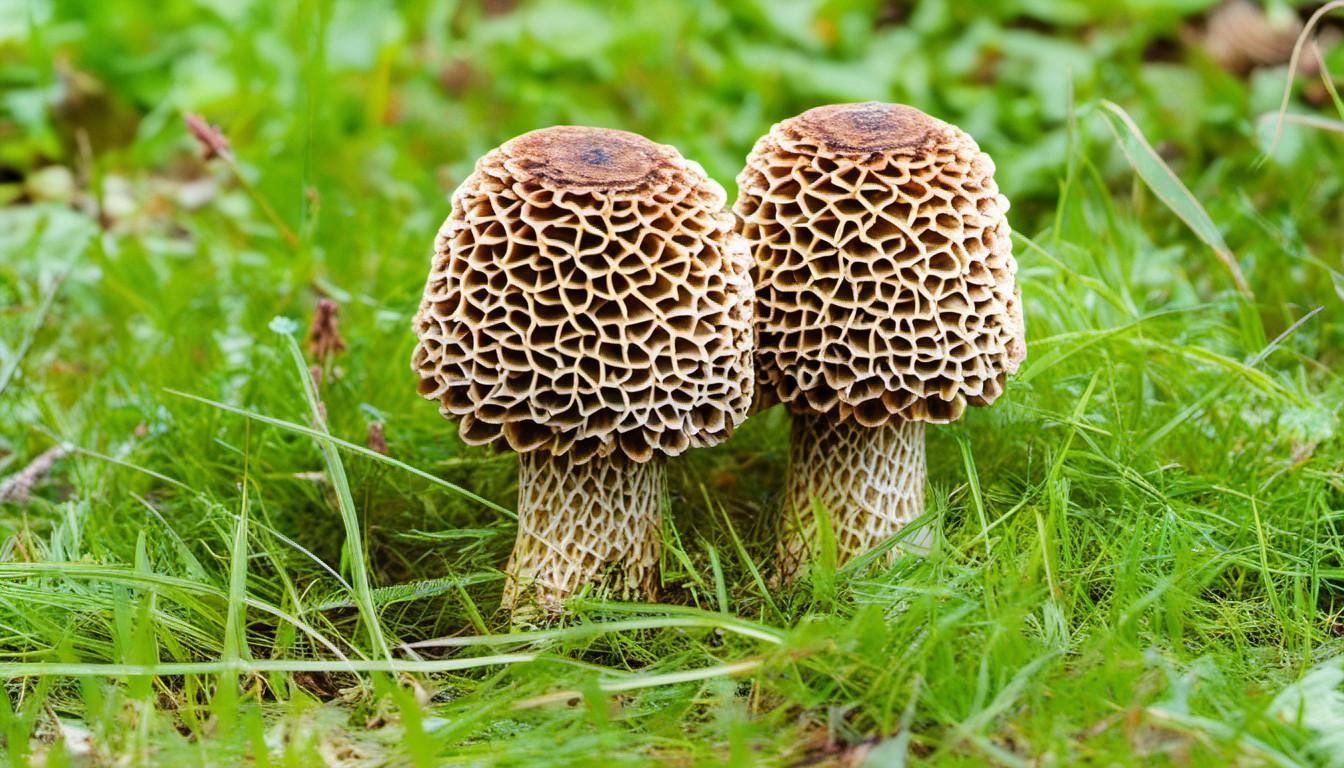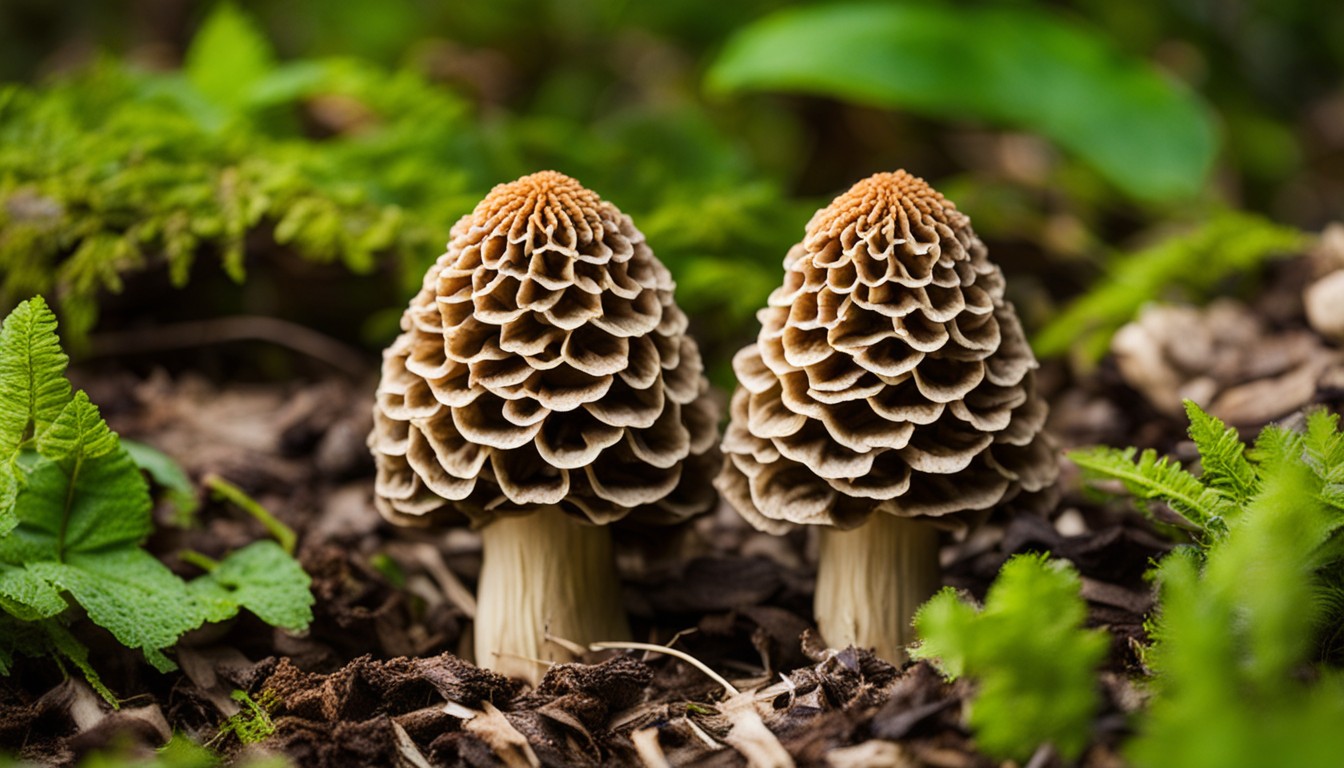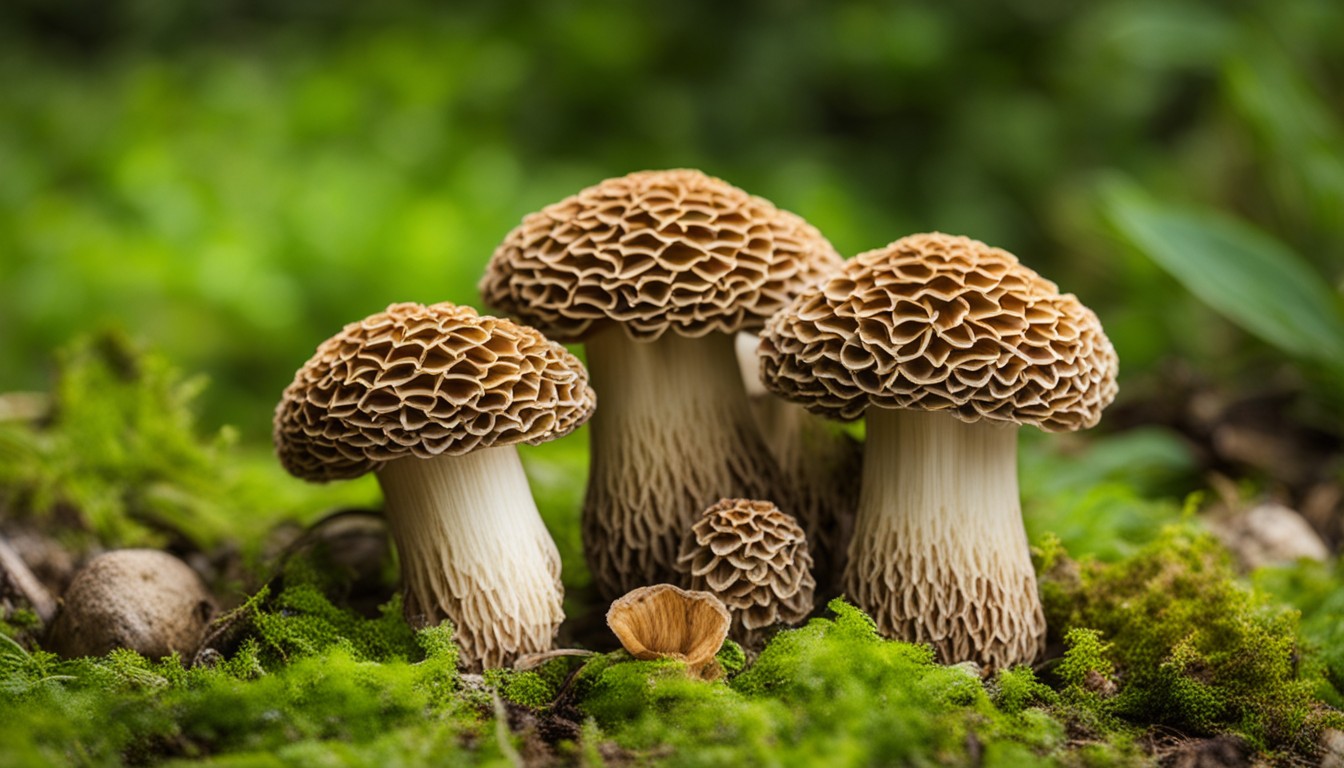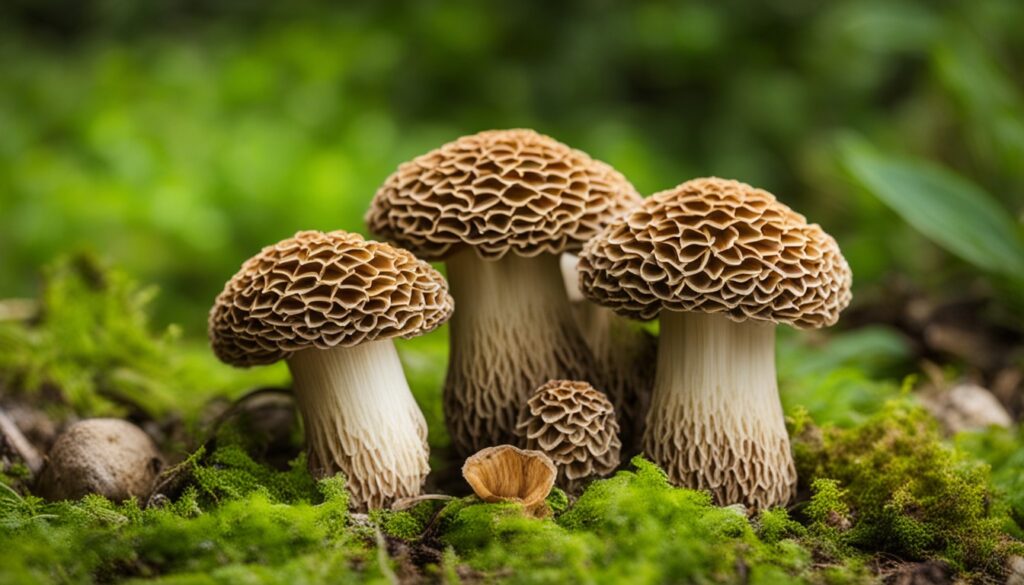Morel mushrooms are a highly sought after delicacy in Arkansas, and for good reason. With its lush forests and diverse ecosystem, the Natural State offers the perfect conditions for these elusive fungi to thrive. In this comprehensive guide, we will explore the best places to find and harvest morel mushrooms in Arkansas, as well as provide tips on identification, ethical harvesting practices, and delicious recipes to enjoy these culinary treasures. So grab your basket and join us on a journey through the enchanting world of morel mushroom hunting in Arkansas.
A Brief Introduction to Morel Mushrooms
The captivating world of morel mushrooms is rich and diverse, encapsulating a coveted treasure in the fungus kingdom due to their unique taste, nutritional value, and elusive nature.
Within the broad mushroom family, morels hold a special place, recognized not only for their distinctive honeycombed appearance but also for their popularity among culinary enthusiasts around the world, igniting a feverish hunt each spring in Arkansas.
What are morel mushrooms?
Morel mushrooms, scientifically known as Morchella, are distinctive fungi recognized for their honeycomb-like appearance. They can grow in a variety of habitats, commonly found in forested areas, orchards, or near decaying trees.
Known as Morchella, morel mushrooms are famous among fungi enthusiasts for their unique honeycomb appearance and their earthy, nutty flavor that delights gourmands every spring season.
These edible mushrooms boast a conical shape and an exterior covered in deep pits and ridges, which lend them a characteristic sponge-like look. Their color can range from grey and yellow to dark brown.
Morel mushrooms have achieved proverbial stardom among mushroom enthusiasts. Their unique taste, described as earthy, nutty, and meaty, combined with their spring-season availability, makes them a much-anticipated delight.
Along with the mouthwatering flavor, these mushrooms are also cherished for their elusiveness. Hunting for these ‘hidden treasures’ adds an adventure aspect, making morels highly valued and pursued in the world of mycology.
Why are morel mushrooms popular?
Morels, the diamonds of the forest, are revered for their sponge-like honeycomb structure and distinctive nutty flavor. Foragers across America and beyond yearn for their unique taste profile, boosting their immense popularity.
The culinary appeal of morel mushrooms is undeniable. Renowned chefs praise them for their earthy and meaty flavor, pairing perfectly with dishes from pastas to roasts, enhancing the gastronomic experience.
The ephemeral nature of morels adds to the allure. Appearing for just a few weeks in spring, enthusiasts participate in the annual ‘hunt’ making their reappearance an eagerly awaited event.
The thrill of the hunt is a significant driver in morel’s popular appeal. Scouting out locations, learning to identify morels and uncovering them amongst woodland detritus provides an adventure lovers relish.
A successfully forged patch of morels can yield high profits. This economic aspect adds to the popularity, providing both a culinary delicacy and a profitable hobby for many lucky enough to find these hidden gems.
The best time to find morel mushrooms in Arkansas
As Morel mushrooms are seasonal, understanding their growth pattern is crucial. In Arkansas, the morel foraging season typically begins in late March and can extend into May, depending on climatic conditions.
The optimal period for morel hunting is a narrow window in spring when the soil has warmed after the last frost, but deciduous trees have not fully leafed out, creating the perfect balance of warmth and moisture.
The intensity of the morel season varies annually, influenced by factors like rainfall and temperature. Overall, the peak period usually occurs in April, representing the most productive time for local foragers.
Remember, while morel mushrooms can bloom in one location one year, they may not appear in the same spot the next. Thus, foragers should be prepared to explore new areas each season, amplifying the thrill of the hunt.
Identifying Morel Mushrooms
The first step in the successful hunt for morel mushrooms is correct identification. These distinctively shaped fungi, known for their honeycombed, sponge-like cap, vary in color from gray to yellow. It is worthwhile to familiarize oneself with the distinct appearance before embarking on the quest.
No two morel mushrooms are identical, but all true morels possess a hollow interior from cap to stem, offering a key characteristic for identification. False morels, on the other hand, lack this feature, which makes accurate identification crucial.
False morels can look deceptively similar to genuine morels but consumption of these imposters can lead to serious illness. An important difference lies in their cap formation. Genuine morels have caps that are fully attached to the stem, unlike false morels.
Another striking feature of true morels is their undulated, irregular caps, unlike the smooth surface common in their toxic look-alikes. Meticulous attention to detail during identification can thus ensure the safety and success of your foraging adventure.
Always remember that if there’s any doubt in identification, it’s safest to leave the mushroom undisturbed. When hunting for morel mushrooms, it is important to be mindful of the old forager’s maxim: ‘When in doubt, throw it out!’
Preparing for Your Morel Mushroom Hunt

Stepping into the world of foraging for morel mushrooms necessitates meticulous preparation. This involves researching optimal mushroom locations, acquiring the suitable gear for hunting, familiarizing oneself with regional regulations, and anticipating Arkansas’s specific weather conditions.
In Arkansas, laying the groundwork for a successful morel mushroom harvest is an in-depth process. Prospects of reaping a bountiful hunt heightens with comprehensive preparation strategies such as understanding timing, deciphering key habitats, and harnessing one’s senses to detect these elusive delicacies.
Researching the best locations
When scouting prime locations for morel mushrooms in Arkansas, it is crucial to take the environment into consideration. Investigate areas with well-drained soil, near dying or dead trees, as morels often thrive here. Delve into resources such as local foraging groups, online forums and morel hunting maps for valuable insights.
Your guide for targeted location research is closer than you think. Local agricultural extension services and the Arkansas Department of Agriculture offer detailed reports and advice. Pair these treasures of information with personal exploration and careful observation to find your ideal morel hotspots.
Getting the right equipment
Your success as a morel hunter hinges largely on your equipment. Necessary gear includes a mesh collecting bag to help disperse spores, a sturdy digging tool to dislodge mushrooms without damage, and comfortable hiking boots for lengthy forays into the wilderness.
Refining your toolkit can markedly improve your morel hunting experiences. Consider investing in a quality field guide to aid in mushroom identification, a hand GPS for navigation and marking productive spots, and a camera to document your findings.
The geography of Arkansas places a premium on appropriate gear. Given the mixed topographies, having an adjustable trekking pole can provide added stability on uneven terrains. Furthermore, a quality bug spray and sunblock should never be overlooked.
Although not essential, tech-savvy foragers might consider a portable, weather-proof device for recording field notes and observations. This can help track growth patterns and increase your success rate over multiple seasons.
Understanding the hunting regulations

Navigating the regulations of Arkansas for morel mushroom hunting is essential. Understanding these rules ensures the legality of your foraging activities. Arkansas outdoor agencies provide comprehensive guides that detail public lands where you can legally hunt.
Visiting the website of the Arkansas Game and Fish Commission (AGFC) is a good starting point. The AGFC outlines specific areas for hunting, preservation efforts, and any restrictions. It keeps mushroom foragers up-to-date with the latest regulations.
From picking limits to closed areas, these rules may change each season. Continuous awareness ensures you respect the ecosystem and local laws, maintaining a sustainable morel hunting practice. This proactive approach ensures the legality of morel mushroom hunting.
Remember, illegal mushroom foraging can lead to serious penalties. Besides, such behavior is detrimental to the area’s biodiversity and mushroom regeneration. Abiding by the hunting regulations protects not just morel mushrooms but also the broader Arkansas environment.
Checking weather conditions
Morels, like many fungi, flourish under certain climatic conditions. You’ll often find a spike in their growth after warm spring rains coupled with cooler temperatures at night in Arkansas.
Keeping a close eye on local weather forecasts serves as a reliable method for timing your morel mushroom hunts. Periods of rain followed by sunny days in the 60s offer the most promising conditions for these fungi to thrive.
Regular study of weather patterns can drastically improve your chances of a successful harvest. Morels prefer wet conditions with soil temperature around 50 degrees, facts that can dictate your foraging plans.
It’s also important to understand how heavy weather interference such as floods and droughts can influence morel growth. Sudden weather shifts, therefore, might require adaptations to your hunting schedule to ensure a productive harvest.
Tips for Finding Morel Mushrooms in Arkansas
Essential characteristics for successful morel hunting in Arkansas revolve around identifying favorable habitats. Places with moist soil, ample shade, and a wealth of decaying organic material frequently attract these elusive fungi.
When it comes to extracting morels from their hiding places, patience, persistence, and a keen eye for detail prove indispensable. Adopting a slow searching approach, focusing on ground level, and thorough examination of prime locations is the winning formula for a fruitful hunt.
The importance of timing
Timing is crucial in the hunt for morel mushrooms. Understanding the peak morel seasons in Arkansas as well as the life cycle of morels can greatly boost your chances of finding these elusive fungi.
- Track the peak morel seasons in Arkansas: Early spring is typically the best time, with late March to late April being prime months.
- Study the life cycle of morel mushrooms: They typically start to appear after a spring rain, when soil temperatures reach about 50-58°F(10-14°C).
- Monitor local weather: Morels prefer wet weather but too much water can be detrimental. Keeping an eye on rainfall levels can ensure a fruitful hunt.
Identifying key habitats
In your quests for morel mushrooms in Arkansas, identifying key habitats can vastly increase your success rate. Morels aren’t found just anywhere; they favor certain environmental conditions and associate with specific types of trees.
- Check environments with sandy soil, as morels prefer well-drained areas.
- Look near elm, ash, aspen, and apple trees – these are favorites among morels in Arkansas.
- Burn areas or spots with a recent disturbance in the forest might surprisingly hold a morel bounty, given their fondness for disturbed habitats.
- Avoid heavily shaded areas; morels favor a blend of sunlight and shade.
Using your senses to locate morel mushrooms
Understanding nuances in smell and touch are keys to locating morel mushrooms. The distinct aroma – beautifully earthy and nutty, becomes more evident as you physically handle morels. The texture, spongy yet firm, is unique to this species.
Visual cues play a crucial role in distinguishing morels from other types. Observe the honeycomb-like structure which covers the cap portion, differentiating them instantly from other varieties.
Keep in mind the colors too. Morels can range from gray or tan in the early season to dark brown or black later in the season. This transition is critical in correctly identifying them.
Take note of their size. Morels generally grow to between two to four inches in height, though some varieties can reach up to twelve inches. Pay attention to these details to boost your mushroom hunting success.
Harvesting Morel Mushrooms Responsibly

When harvesting morel mushrooms in Arkansas, it’s imperative to cut them at the base, leaving the mycelium in the ground to promote future growth. Over-harvesting destabilizes the ecosystem and depletes future yields, reminding us that sustainable methods are key to preserving the treasure of morel hunting for years to come.
The proper way to pick morel mushrooms
Implementing effective techniques for harvesting morel mushrooms is crucial in Arkansas. The ideal way involves pinching or cutting them at the base without uprooting, which helps the mycelium—the vegetative part of the fungus —to produce mushrooms in the future.
Gathering morel mushrooms in the right manner not only preserves their quality but also contributes to their sustainable habitat. Here’s a tip: Carry a mesh bag during your hunt. The spores can disseminate and populate new areas as you traverse.
One must exercise caution while picking morel mushrooms. It is advised to avoid those growing near poisonous plants or polluted areas, as mushrooms are known for absorbing toxins from their environment, making them potentially harmful for consumption.
Consistency is key when it comes to mushroom hunting. Remember to frequent the same successful spots year after year, as morels tend to recur in the same places. With the right techniques and consistency, one can enjoy plentiful and safe harvests.
While hunting, it is best to leave the younger morel mushrooms intact. They will continue to grow and reproduce, ensuring a healthy population for future foragers. This approach ensures a sustainable mushroom hunting practice.
Avoiding damage to the ecosystem
While venturing into Arkansas’ wilderness for morel mushrooms, respect for the environment is paramount. Carefully navigated trails and deliberate avoidance of trampling vegetation minimizes harmful impacts.
Sustainability underscores all aspects of morel mushroom hunting. This involves leaving smaller mushrooms and those near water bodies, protecting future generations and contributing to the ecological balance.
Good practices for sustainable foraging foster an enduring morel mushroom population. These include rotating hunting spots yearly, allowing spores to drop before collection, and at all times adhering to ‘Leave No Trace’ principles.
Tips for Enjoying and Preserving Morel Mushrooms
Harvested morels can be thoroughly appreciated by employing the correct preparation and preservation methods. From drying to freezing, finding the ideal technique can make the most of your morel harvest.
Morels, like any treasure, require special handling for optimum quality and longevity. Proper storage is vital, whether it’s keeping them fresh in a paper bag inside a fridge, or for long-term storage, dehydrating and storing in airtight containers.
Cleaning and storing morel mushrooms
Conscientious cleaning and storage are crucial to ensure the flavors of your morels linger. Begin by gently brushing off any obvious debris then rinse them under cold water. This removes any hidden grit for enjoyable consumption.
The key to properly storing morels is to uphold their texture and taste. After cleaning, pat them dry and store in a paper bag within your refrigerator. This allows them to retain their natural moisture while preventing excess dampness.
Preserving morels for longer periods means employing effective drying methods. Use a dehydrator or oven set at a low temperature to gradually dry your morels, while preserving their unique flavor and texture.
For those considering freezing their morels, remember to blanch them first. This process ensures they retain most of their texture after thawing, letting you savor the taste of these unique mushrooms no matter the season.
Delicious recipes to try with morel mushrooms
Sprucing up your culinary creations with morels harvested from Arkansas is an adventure in its own right. There’s a whole plethora of recipes awaiting you, be it a decadent morel risotto, a comforting morel and chicken pot pie, or simply sautéed morels in butter garlic.
Want a gourmet touch to your meals? Morels are easy-to-cook and versatile. You can simply grill them with olive oil, salt, and pepper or be a bit adventurous and try them in a creamy sauce or soup. Their unique flavor pairs beautifully with eggs, meat, and even pasta.
Stepping away from the complex culinary world, morels are just as delightful in straightforward comfort food. From morel scrambled eggs for breakfast to a morel-laden pizza for dinner, the possibilities are endless and exciting with your beloved Arkansas morel harvest.
Frequently Asked Questions (FAQ)
What makes Morel mushrooms in Arkansas so elusive and sought after?
Morel mushrooms in Arkansas are highly prized due to their unique flavor, meaty texture, and limited availability. These mushrooms tend to be elusive because of their brief growing season, specific habitat requirements, and their ability to blend seamlessly into the forest floor.
When is the best time to hunt for Morel mushrooms in Arkansas?
The prime time to search for Morel mushrooms in Arkansas is typically during the springtime, specifically from late March to early May. This period is characterized by the perfect combination of soil temperature, moisture, and weather conditions that promote the growth of Morel mushrooms.
Where can I find Morel mushrooms in Arkansas?
Morel mushrooms can be found in various habitats throughout Arkansas, including deciduous forests, river bottoms, and recently burned areas. Look for areas with rich organic material, such as dead trees, fallen leaves, and decaying logs, as they provide the ideal environment for Morel mushrooms to flourish.
How can I identify Morel mushrooms in Arkansas?
Morel mushrooms in Arkansas have a distinct appearance characterized by their cone-shaped caps, honeycomb-like patterns, and hollow stem. Their caps range in color from light tan to dark brown, often blending with the forest floor. It’s important to note that proper identification is crucial, as some look-alike mushrooms can be toxic or inedible.
What are the ethical guidelines for harvesting Morel mushrooms in Arkansas?
To ensure the sustainability of Morel mushrooms in Arkansas, it is essential to follow ethical harvesting practices. These include only taking mature mushrooms, leaving behind small or immature specimens to allow for future reproduction, and avoiding damage to the surrounding habitat. Additionally, make sure to obtain any necessary permits or permissions from landowners or public land management agencies.
What are some popular ways to cook and enjoy Morel mushrooms?
Morel mushrooms can be prepared in various delicious ways, such as sautéing them in butter, adding them to cream-based sauces or soups, or using them as a flavorful topping for pizzas and pasta dishes. Their unique flavor profile pairs well with ingredients like garlic, herbs, and cream. Remember to thoroughly cook Morel mushrooms before consuming to enhance their taste and eliminate any potential toxins.
Are there any similar edible mushrooms that can be found alongside Morel mushrooms in Arkansas?
While Morel mushrooms have their own distinct characteristics, they can often be found alongside other edible mushrooms in Arkansas. Some of these include the chanterelle, oyster mushroom, and chicken of the woods. It’s important to familiarize yourself with the identification features of each species to ensure safe foraging practices.
Can I cultivate Morel mushrooms in my own backyard in Arkansas?
Cultivating Morel mushrooms can be a challenging task as they have complex growth requirements and a symbiotic relationship with specific tree species. While there have been attempts to cultivate Morel mushrooms, success rates vary, and it is generally more reliable to forage for them in their natural habitat.
Conclusion
The thrill of the hunt, the joy of discovery, and the triumph of mastering the art of identifying morels define the unforgettable experience of morel mushroom foraging in Arkansas. It sparks a vibrant tapestry of inspirations leading to unique culinary experiments and fond memories that linger, fueling a yearning for the next morel season.
- Reflection on the morel hunting experience – the excitement, learnings, and successes
- A farewell to morel hunting season – the inspirations, culinary creations, and cherished memories

